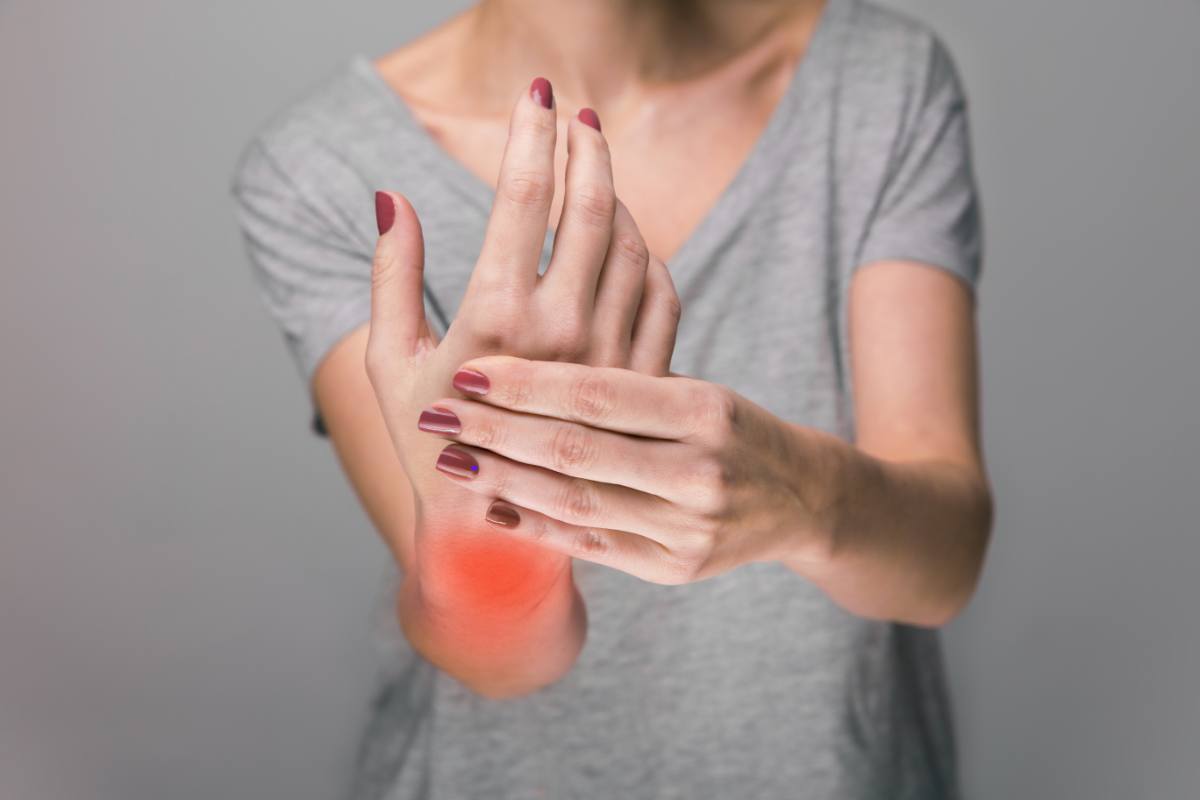Osteoarthritis of the hand is a degenerative pathology that gradually impairs patients’ quality of life. Given the limitations of conventional treatments, cannabidiol (CBD) is attracting growing interest for its anti-inflammatory and analgesic properties. This article explores the use of CBD in the treatment of osteoarthritis of the hands, based on the available scientific data.
What causes osteoarthritis of the hands?
Osteoarthritis of the hands is a degenerative disease resulting from the progressive deterioration of articular cartilage. This process, which is often irreversible, is the result of a complex interaction between several factors. On the one hand, mechanical factors, such as repeated microtrauma or overloading of the joints, play a key role in accelerating the wear and tear of the cartilage. On the other hand, genetic predisposition can influence joint vulnerability, making certain individuals more susceptible to developing the disease. Finally,chronic inflammation contributes to this deterioration by promoting the destruction of joint tissue.
Clinically, osteoarthritis of the hands manifests itself as chronic joint pain, often exacerbated by exertion or climatic changes. This is compounded by morning stiffness and a gradual reduction in mobility, limiting daily activities. The affected joints may also show visible deformities, particularly in the form of bone nodules in the interphalangeal joints, which characterise the advanced stages of the disease.
What are the 4 stages of osteoarthritis of the hands?
| Stage | Description |
|---|---|
| Stage 1: Early osteoarthritis | Mild discomfort with no visible radiological changes. |
| Stage 2: Moderate osteoarthritis | The first signs of cartilage wear are visible, with more frequent pain. |
| Stage 3: Advanced osteoarthritis | Pain becomes persistent with significant joint deformity. |
| Stage 4: Severe osteoarthritis | Almost total loss of cartilage, leading to disabling pain and marked immobility. |
How does CBD help osteoarthritis of the hands?
Cannabidiol (CBD) exerts its therapeutic action on osteoarthritis of the hands by interacting with the endocannabinoid system (ECS), a biological network essential for regulating various physiological processes, including pain and inflammation. This system comprises two main receptors: CB1 and CB2. CB1 receptors, mainly located in the central nervous system, are involved in modulating neuronal signals linked to pain, while CB2 receptors, predominant in immune cells, play a crucial role in regulating inflammatory responses.
Recent studies show that CBD, although it does not bind directly to these receptors, influences their activity by an indirect mechanism. This modulation leads to a reduction in the release of pro-inflammatory cytokines, proteins that amplify inflammation in the joint tissues affected by osteoarthritis. By reducing the concentration of these inflammatory mediators, CBD helps to reduce local inflammation, a key factor in the degradation of cartilage and the onset of joint pain. (1)
CBD also acts on pain transmission pathways. By inhibiting the release of excitatory neurotransmitters in the central nervous system, it blocks the propagation of pain signals from the affected joints to the brain. The result is a perceptible reduction in joint pain, even in cases of advanced osteoarthritis.
Finally, CBD may also influence other neurochemical systems, in particular by increasing levels of anandamide, a natural endocannabinoid often referred to as the ‘happy molecule’. This synergistic effect reinforces the analgesic and anti-inflammatory action of CBD, making it a promising therapeutic option for the treatment of osteoarthritis of the hands. However, although the mechanisms of action are becoming better understood, in-depth clinical studies are still needed to validate these effects and optimise dosages for each patient profile.
What are the benefits of CBD transdermal gel?
CBD transdermal gel stands out for its ability to target the affected areas directly:
- Localised action: Allows a high concentration of CBD in the joint tissues.
- Reduced systemic side effects: Avoids passage through the digestive system and liver.
- Improved adherence to treatment thanks to simple, non-invasive application.
A recent study showed a significant reduction in pain scores and an improvement in grip strength after four weeks’ use of a CBD transdermal gel. (1)
What is the best ointment for osteoarthritis of the hands?
Among the options available, CBD gels, oils and creams enriched with tocopherol (TPM) offer better skin absorption and prolonged action. These products combine the benefits of CBD with permeation enhancers, increasing their clinical efficacy.
How can I stop the progression of osteoarthritis in my hands?
Although osteoarthritis of the hands is an irreversible degenerative pathology, it is possible to slow its progression through appropriate treatment. Regular, targeted physical activity remains essential to strengthen muscles and maintain joint mobility. These exercises help to stabilise the affected joints, reducing stiffness and loss of function.
The use of topical treatments, such as cannabidiol (CBD)-based gels, also offers an effective solution for relieving symptoms. Applied topically, CBD acts on inflammation and pain, providing significant comfort without the side effects associated with oral anti-inflammatories.
In addition, diet plays a key role in modulating systemic inflammation, particularly via the intestinal microbiota. This microbiota, made up of billions of micro-organisms, has a direct influence on inflammatory processes. Imbalances in the microbiota, or dysbiosis, can exacerbate systemic inflammation, thereby contributing to the worsening of osteoarthritis. A diet rich in fibre, prebiotics and probiotics promotes a healthy microbiota, capable of regulating inflammation and improving joint health. In this context, CBD acts in synergy with these nutritional approaches, reinforcing their anti-inflammatory effects and contributing to effective overall disease management. (2)
Can CBD cure osteoarthritis of the hands?
The use of cannabidiol (CBD) in the treatment of osteoarthritis of the hands represents a promising advance in improving patients’ quality of life. Initial studies suggest encouraging results, particularly in terms of pain relief and reducing inflammation. However, further clinical research is crucial in order to optimise usage protocols and establish solid therapeutic recommendations.
Before starting a CBD treatment, it is imperative to consult a healthcare professional, who will be able to assess the appropriateness of this approach according to the specific needs of each patient. Choosing certified CBD products, available in particular from online pharmacies, guarantees not only their quality but also their safety. Finally, to maximise the benefits, the use of CBD should form part of an overall therapeutic strategy that includes lifestyle adjustments, appropriate physical activity and a balanced diet. This holistic framework makes it possible to take full advantage of CBD’s properties while optimising the management of osteoarthritis.
Sources
- Bawa, Z., Lewis, D., Gavin, P.D. et al. An open-label feasibility trial of transdermal cannabidiol for hand osteoarthritis. Sci Rep 14, 11792 (2024). https://doi.org/10.1038/s41598-024-62428-x
- ME Chriswell, et al. Clonal IgA and IgG autoantibodies from individuals at risk for rheumatoid arthritis identify an arthritogenic strain of Subdoligranulum. Science Translational Medicine DOI: 10.1126/scitranslmed.abn5166 (2022).





